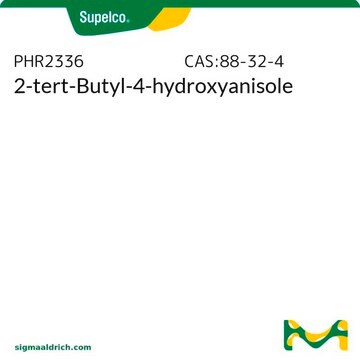20021
3-tert-Butyl-4-Hydroxyanisol
≥98% (sum of isomers, GC), ≤10% 2-BHA basis (GC)
Synonym(e):
2-tert.-Butyl-4-methoxy-phenol, 3-BHA, BHA
About This Item
Empfohlene Produkte
Assay
≥98% (sum of isomers, GC)
Form
solid
Zusammensetzung
2-BHA, ≤10% GC
3-BHA, ≥90% GC
Verunreinigungen
≤1% 4-hydroxyanisole
Glührückstand
≤0.05%
mp (Schmelzpunkt)
48-63 °C
Löslichkeit
ethanol: soluble 1 g/10 mL, clear, colorless to faint yellow or tan
SMILES String
COc1ccc(O)c(c1)C(C)(C)C
InChI
1S/C11H16O2/c1-11(2,3)9-7-8(13-4)5-6-10(9)12/h5-7,12H,1-4H3
InChIKey
MRBKEAMVRSLQPH-UHFFFAOYSA-N
Suchen Sie nach ähnlichen Produkten? Aufrufen Leitfaden zum Produktvergleich
Verwandte Kategorien
Allgemeine Beschreibung
Anwendung
- Regulation of Smad signaling in mesenchymal stem cells: 3-tert-Butyl-4-hydroxyanisole disrupts the differentiation of C3H10T1/2 mesenchymal stem cells into brown adipocytes by modulating Smad signaling pathways, with potential implications for obesity and metabolic syndrome research (Wang et al., 2023).
H-Sätze
P-Sätze
Gefahreneinstufungen
Aquatic Chronic 2
Lagerklassenschlüssel
11 - Combustible Solids
WGK
WGK 2
Flammpunkt (°F)
Not applicable
Flammpunkt (°C)
Not applicable
Persönliche Schutzausrüstung
Eyeshields, Gloves, type N95 (US)
Analysenzertifikate (COA)
Suchen Sie nach Analysenzertifikate (COA), indem Sie die Lot-/Chargennummer des Produkts eingeben. Lot- und Chargennummern sind auf dem Produktetikett hinter den Wörtern ‘Lot’ oder ‘Batch’ (Lot oder Charge) zu finden.
Besitzen Sie dieses Produkt bereits?
In der Dokumentenbibliothek finden Sie die Dokumentation zu den Produkten, die Sie kürzlich erworben haben.
Kunden haben sich ebenfalls angesehen
Unser Team von Wissenschaftlern verfügt über Erfahrung in allen Forschungsbereichen einschließlich Life Science, Materialwissenschaften, chemischer Synthese, Chromatographie, Analytik und vielen mehr..
Setzen Sie sich mit dem technischen Dienst in Verbindung.








